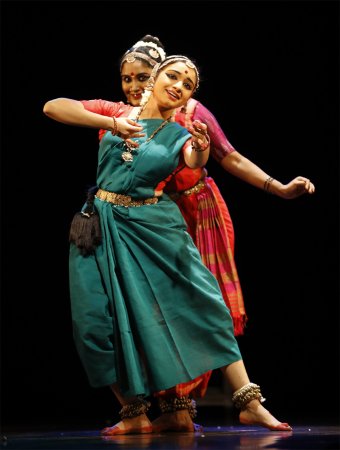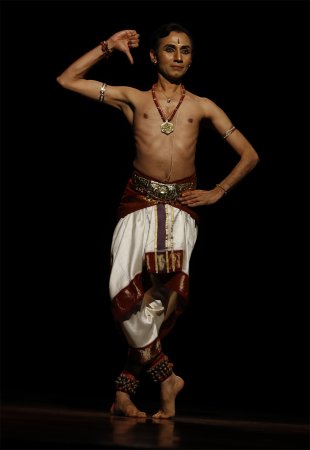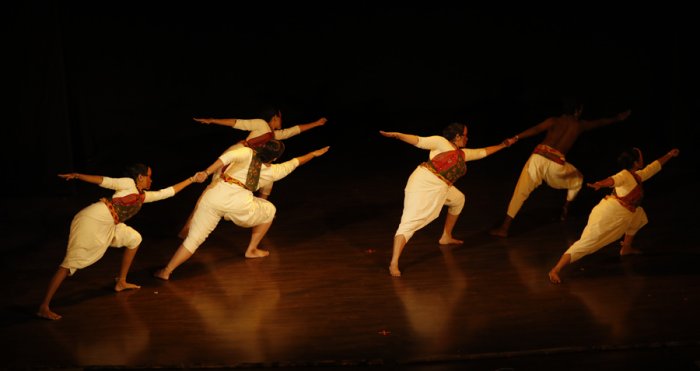
|   |

|   |
Natya Darshan performances - Day 1 - Sukanya Kumar e-mail: sukanya.kumar91@gmail.com Photos courtesy: Natya Darshan January 4, 2020 The 19th edition of Natya Darshan Conference 'Kadamba - the flowering path' was themed around the physical, emotional and spiritual impact of arts. Answering the questions that curator Priya Murle posed to the dancers, Sreelakshmy Govardanan and Meera Sreenarayanan presented 'Parinama,' a reflection of their process of understanding the evolution of consciousness and the synergy of their styles. Sreelakshmy, disciple of Guru Pasumarthy Rattaiah Sarma, through Kuchipudi, and Meera, under the mentorship of Guru Indira Kadambi, through Bharatanatyam explored the aspects of physical, emotional and spiritual in three distinct sections that segued into each other.  Sreelakshmy Govardanan and Meera Sreenarayanan They commenced their "journey through transformation" with the tangible body. With the popular slokam Angikam bhuvanam yesya, they presented a nritta oriented section which explored their respective styles independently and simultaneously. With some sections of synchronous 'churning' movements, they expressed the 'churning of one's mind' transitioning into the second section exploring the mind. The churning resulted in the birth of Kannagi and Madhavi, two characters from the Silappadikaram, played by Meera and Sreelakshmy respectively. They love in passion, weep in separation, avenge in rage and detach in silence. The section where Kovalan moves in with Madhavi and betrays Kannagi was well portrayed with simultaneous contrasting actions and emotions of gain and loss. K.S. Balakrishnan on embellished nattuvangam, Bhagyalakshmi on mellifluous vocal, and GRS Moorthi on spirited veena provided enhancement to the powerful composition of Rajkumar Bharathi. With the support of Dr. Raghuraman as the resource guide, the choreography justified the emotional depth of the epic. The third and final section explored spirituality where the characterization was forgotten. Yearning for "sachitanandam," the dancers used the Kundalini Pattu of Sree Narayana Guru 'Aadu pambe punam thedu paambe,' with Harihara Guptan on mizhavu and Vedakrishnaram on mridangam and damaru adding special effects to the chant. The culmination of energy was impactful and touching, embellished by creative lighting by Jose. The costume of simple draped saree with minimalistic adornments, fitting with current trends was appropriate to the topic of going beyond the physical. While Meera's belt breaking was a mild irritant to the dancer, the choice of costume and ankle bells did not bring forth the difference in their styles. Although they presented Kuchipudi and Bharatanatyam, their production was proof that dance beyond the attire is essentially same even for different styles.  Praveen Kumar 'Pandharpur' conceptualized and choreographed by Praveen Kumar showcased the maturity and understanding of the artiste and his training under illustrious artistes like Guru (Late) Narmada and Guru C.V. Chandrasekhar. Commencing with a powerful and energetic Pandurangashtakam, depicting the duality of Shiva and Vishnu, he then presented a series of stories through abhangs. Starting with 'Sundarate dhyan', Praveen depicted the birth of Namdev. The story of Dhama Seth and Goniachi was delineated in aesthetic detail. While establishing the character of Dhama Seth, the tailor, actions to depict 'taking measurements', 'locking the door', 'washing the feet at home' combined relatable lokadharmi with artistic natyadharmi. The abhang 'Pandharicha vaas' was melodiously rendered by vocalist Ganesh Desai. In the second story of jewel merchant Narahari, Praveen elaborated on how his single-minded belief in Shiva is challenged by Vithala. The section where Narahari will close his eyes and measure Vithala's statue only to experience aspects one would find on Nataraja was beautifully portrayed. Praveen faced the audience as Narahari and faced the other way as Vithala, enhanced by well-timed effective lighting by Murugan. 'Shambhava he re kailash natha' described Vithala as the form that is both black and white, both Shiva and Vishnu. The last piece 'Shiva ani Vishnu' was a stirring finale in the form of Keertana Bhakti. Some words like 'zhale', 'ani', 'ekashi', 'pandharicha' to name a few are very specific to Marathi language and needed more attention and accuracy in pronunciation both in dialogues and lyrics. Praveen's performance with his signature crisp movements, simplistic approach to choreography, genuine emotions and involved performance was evocative. "Never having heard many abhangs before, the process of creating this production has given me some inner solace, both professionally and personally," Praveen shared his thoughts. Prasanna Kumar on nattuvangam, Lingaraju on mridangam, Mahesh Swamy on flute and Anoor Prabodh on pakhawaj provided strong unobtrusive support that added impact to the production.  Gandhi The final production 'Gandhi,' a brainchild of C.P. Satyajit, explored the social and political philosophies of Gandhi in a non-linear abstract presentation. Instead of an opinionated viewpoint, the approach was more experiential, based on applying the ideologies of Gandhi - like looking into oneself, to the individuals involved, both dancers and rasikas. Inspired by Western thought processes and dance methodologies, the presentation used dialogue that was written and recited by the dancers, simultaneous singing (by dancers) in different speeds, a capella like recitation of alarippu syllables in a sequential format, exploration of floor space in seated movements, and expressing using body kinetics and not the face. The introduction of these "foreign movements" in "Bharatanatyam trained bodies" was "a challenging learning experience" was the unanimous opinion of dancers Deepthi Ravichandran, Lekha Prasad, Gayathri Rajaji, Sanjana Prasad, Siva Das, Sukanya Pannerselvam, and Uma Namboodripad, expressed in the interaction that followed. C.P. Satyajit shared that "the involvement of the dancers was very important to the process, where they took Charkha workshops to understand Gandhi way of life that helped choose elements that would translate well on stage." The simplistic costumes and melodious recorded music were apt characterization of Gandhian concepts. Sukanya Kumar is a practitioner of Bharatanatyam and Kathak genres trained under illustrious gurus. She is a Creative Culturist, and choreographer skilled in implementing electronic media technology in her productions to propagate social messages. She has a BSc in electronic media, MFA in Bharatanatyam, MBA in Educational management and MFA in Dance and Technology. |